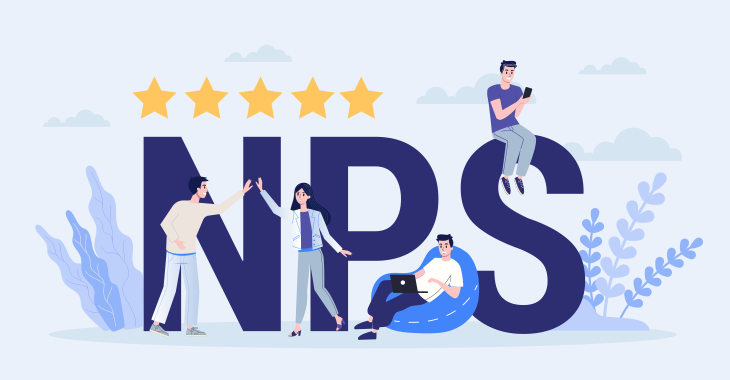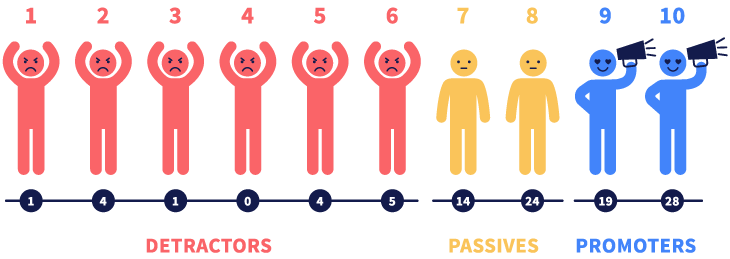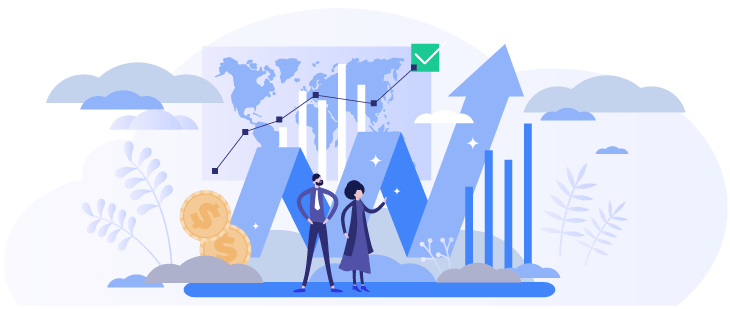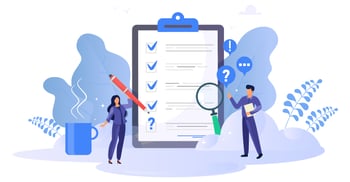
Net Promoter Scores - The Complete Guide for Your SaaS Business
Out of all the SaaS trends and tools, the net promoter score enjoys the highest popularity level. When it comes to the question “how do I improve my net promoter score,” there isn’t one correct answer, but there are several common truths that you can weave together to increase your business strategies’ success. We’re going to take you through the complete guide to net promoter score for your SaaS business and the why, where, and how you can better them.
NPS Basics
Net promoter scores are helpful across all industries, particularly B2B industries like SaaS. Before we outline how to make them work for you, let’s get to grips with some basics about the model.
What is a Net Promoter Score?
They are determined using feedback gathered from customer surveys. They are standard benchmarking metrics that show whether your business is reaching its goals. This gives you insight into how you can improve your processes. The NPS score is hugely relevant when considering how to sell SaaS online better.
The idea behind net promoter scores is to help businesses create the most user-friendly customer experience. You give your customers a voice to help you understand their wants/ needs and how you can cater to these. NPS surveys focus on one thing and one thing only - would your customers recommend your business?

How is a Net Promoter Score Calculated?
Once you’ve collected your NPS surveys, it’s time to start making sense of the feedback. From survey answers, customers are sorted into three categories: promoters, passives, and detractors. They are arranged according to what they gave as scores out of 10, and these are used to work out the scores.
Promoters = 9 or 10 rating. These are your most positive customers and are most likely to recommend your SaaS services.
Passives = 7 or 8 rating. These are your more laid-back customers, who don’t hold strong opinions either way about your business.
Detractors = 0 to 6 rating. As the name suggests, these are your most negative customers and are the least likely to recommend your services.
After you’ve categorized your customers, it’s time to get calculating. NPS are presented as numbers, not percentages. Your score is the difference between your promoter percentage and detractor percentage.
Basically: % of promoters - % of detractors = your NPS.
If your overall percentage of promoters were 70 % and detractors 20 %, your NPS would be 50. The higher your score, the more happy customers you have and vice versa. For example, 80 indicates your customers are real fans and have been singing your praises via referrals.
When and Where Should NPS Surveys be Used?
Surveys are handy tools, but misusing them could negatively affect your business. You have to get the delivery just right. Think about it for a moment. How many surveys have you been sent via emails that have sat at the bottom of your inbox for years? Are you happy when someone nags you consistently to fill one out?
While customer feedback is needed to generate net promoter scores, you don’t want the process to send your customers running for the hills! It’s imperative to look at where and when you issue surveys.
No 3rd party integrations. No hidden costs. No wasted time.
Just a solution as unique as your business’s needs.
Where?
We suggest using surveys in an in-app prompt. You’ll reach your customers directly, and it’ll take them less time to respond. In-app prompts are a great way to understand feature experience and improve product design. For example, a lot of apps use pop-ups to ask for feedback.
When?
To avoid annoying your customers, you need to get your survey frequency right to suit your business and customer base. This frequency depends on the type of survey you’re sending out.
Transactional surveys, which measure customer satisfaction following an event, will differ from relationship surveys, which measure overall customer satisfaction. For example, since you can include SaaS free trial users in your surveys, you should send relationship surveys 3-5 days after a user signs up for a free trial. You should send transactional surveys 1-2 days after a customer has bought a product.
Key NPS strategies you Need to Use
It’s tough to get higher NPS scores in the SaaS world, but tough doesn’t equal impossible. To make the most out of your surveys, you need to use tried and tested tactics that you know will work.
Determining an accurate score relies on getting to the ‘why’ behind what a customer has rated your business. You need to follow-up with your survey respondents and ask why they feel the way they do about your services. These answers give you context for assessing and using the data. How do you find the ‘why?‘
Below we’ve compiled our top strategies which SaaS businesses can use to skyrocket their NPS. Let’s dive in!
Audience Segmentation
The first strategy we’d suggest for improving net promoter scores is audience segmentation. the first step is to build an online community for your SaaS business. Once you do that, you need to to divide it into groups. Segmenting your audience allows you to identify subgroups and build up buyer personas, targeting them with tailored messages.
By singling out customers who will be loyal to your brand, you identify who you should direct your best resources toward. This will make your future sales strategies more effective, and your content will resonate more strongly.
PayPro Global can filter and analyze your NPS survey responses using premium marketing tools. With our help, you’ll make strategic decisions to perfect your marketing campaigns, like creating accurate buyer personas for placement at the center of your campaigns.

NPS Promoter Engagement
Reaching out to your promoter subgroup is a solid NPS strategy as it helps you pinpoint what features of your product or service are desirable. By finding out exactly why promoters love your product, you can duplicate the feeling for more customers. More happy customers = higher net promoter scores.
To make the most of their enthusiasm, try offering more opportunities for promoters to get involved with your SaaS. For example, ask them to write testimonials for your website so they can express what your business works for them.
Another way to use promoters to improve NPS is to make sure you show them that you’ve considered their advice. When you ask customers for recommendations on improving your services for them, acknowledge them. This will make them more likely to share your services with their networks.
NPS Passive Engagement
As we’ve already mentioned, passives are customers who have a neutral attitude toward your product or service. While counterintuitive, net promoter scores can be improved by engaging with disinterested customers. The trick in using their responses to your advantage is to figure out how you can spark their interest. Understanding why they are neutral will help you zoom in on how to excite them, so they become promoters.

NPS Detractor Engagement
As the most at risk for churn, distractors are the respondents you need to listen to first. When you locate your detractors, you pinpoint who your competitor might gain before they do. Engaging them means redirecting their attention back toward your SaaS.
How do you do this? By contacting them and trying to solve their pain points. Follow-up interviews are a great way to engage with detractors. It's a way to subtly convince them to give your services another try if you fix what upset them. Good questions to ask would be around price point, ease-of-use and functionality.
Partaking in constructive conversations with detractors improves NPS. You'll be able to fix their issues and answer support tickets more succinctly. Make sure to be warm, open, and friendly when reaching out to detractors. You don’t want them to feel pressured or like they’ve done you wrong by being honest.
Identify Patterns in Feedback

Another tactic for improving net promoter scores is identifying patterns within the feedback. Finding common perspectives can help you link customer feelings with higher or lower scores. You can then analyze these links to see more detail on your subcategories’ customers.
Once you have this information, you can calibrate your messaging to speak the language of your subcategories. For example, if you find that most of your promoters are more prominent companies, you can rework your messaging to appeal to them.
Follow-up NPS Surveys
Crafting follow-up surveys to original NPS surveys is a powerful tactic for improving your overall scores. Follow-up surveys allow for analysis of the whole customer experience by pushing for more specific feedback.
Following up with customers via emails or calls is a great way to connect directly with these customers and gather more intel on their feelings. The more specific the information, the bigger the growth opportunity for net promoter scores.
Text Analysis of NPS Comments
To understand the intention behind what respondents wrote in the surveys, you’ll need to conduct a thorough analysis of the text in the comments. Some customers will be transparent in why they like or dislike your product and score in the way they did, while others might be more guarded with their thoughts.
Using text analysis to improve net promoter scores means sifting through comments with a fine-tooth comb. Start by grouping comments into topic groups and adding the number of subcategory respondents under each topic. It’s also helpful to include details about the respondents, like their industry or persona.
Measure NPS Against Everything
You need to map everything in your business against and around your NPS. From marketing to sales, they can be used to guide improvement in all sectors of your SaaS business.
If you modify a product and then conduct an NPS survey, you can look at the results to pick up positive and negative trends. Before and after, good and bad - it’s all useful for development! This is particularly helpful for planned product redesigns, or service revamps.
Net promoter scores are excellent measuring sticks. But it's essential to remember that they're misleading if used in isolation. Make sure you use yours in conjunction with other metrics or KPIs.
Valuable metrics to use with net promoter scores are:
Customer satisfaction level.
Churn rate.
Business growth.
Customer loyalty.
SaaS Retention rate.
Customer lifetime value (how much your business earns per customer).
Customer effort score (measures customer service satisfaction).
Create a Customer-Centric Culture
Our final tactic for this read is to create a customer-centric culture for your SaaS business. You know how important it is to measure customer success in SaaS businesses. Customer-centricity requires placing your customer's happiness at the heart of your business. From the center, it should radiate out, guiding every other aspect of your services.
One way to foster and nurture this culture is to communicate with your staff. You must make sure all departments understand and use the NPS in fulfilling their roles. For example, net promoter scores can be displayed in offices and discussed in meetings.
No 3rd party integrations. No hidden costs. No wasted time.
Just a solution as unique as your business’s needs.
What are the Benefits of Using Net Promoter Scores?
So we’ve outlined the basics of net promoter scores and how best to use them. But if you follow these tactics, what exactly do you gain? Is it worth it? If your NPS strategy is done correctly, it can hold enormous benefits for B2B SaaS businesses.
Here are some specific advantages businesses gain from using them:
Easy and Cost-Effective
Net promoter scores are cost-effective metrics because surveys are easily incorporated into campaigns. NPS surveys are low admin as they can take less than 30-seconds to complete. You save on costs by saving your customers time!

Improves Customer Engagement
As surveys are self-administered, customers can access them quickly and respond immediately. There's no hassle or delay that comes with back-and-forth communication. The speed and convenience which this offers increases response rates and keeps customers happy.
Increases Growth
Net promoter scores can establish an environment for enduring viral growth. Remember - your NPS is an indication of business success. A good score means higher recurring revenue, retention rates, and customer satisfaction.
For example, happy customers are more likely to refer you to their friends. These referrals are converted into leads and, eventually, revenue. Customers become net promoters for your services because you've made sure they’re happy - it’s a win-win relationship.

Improves Upsell
Net promoter scores are effective for improving the upsell of your SaaS products or services. From NPS survey feedback, teams can improve their services and customers’ experience on every level. By listening to customers and fulfilling their desires, you’ll be better placed to know who you can persuade to buy add ons or upgrades.
Improves Customer Satisfaction
In the B2B SaaS sector, we are always looking for ways to halt customer churn rates and unsubscriptions. You stop churn by making it, so customers don’t want to leave.
Net promoter scores help businesses stop churn by indicating if they meet customers' needs and wants. You'll be able to ensure that your customers can solve their problems using your services, keeping them happy with the product and more likely to continue with their subscription.

Simple but Effective
Using net promoter scores is also a great way to pour efficiency into your business. By ensuring all your teams place your NPS first, each department’s goals will align.
For example, different departments in your business can use survey feedback to share data and collaborate. This adds cohesion to your business as your campaigns will be inter-departmental and work together toward a common goal. Paying attention to net promoter scores makes streamlining simple.
Final Thoughts on Using Your NPS for Customer Success in SaaS
There’s a reason people say failure is good. While it's great to receive good feedback, real growth is often found in how we make up for our shortfalls. Creating strategies to improve your NPS is a great way to turn your pitfalls into praise and enhance the way you sell software online. Who knows, maybe you’ll have more promoters in your customer bundle than you know what to do with! The point is you’ll never know how your customers feel about you until you ask.
At PayPro Global, we can help you navigate net promoter scores to get the best score for your business. Contact us today - we’d love to work with you and find out how together, we can improve your NPS and increase your revenue.
FAQ
What is a good NPS score for SaaS companies?
Over the SaaS industry, the NPS score is usually between around 28 and 31. A score of 50 would be an impressive feat for a SaaS company and would easily set you apart from the crowd.
What is a good NPS score B2B SaaS?
There is no definitive number here, but the nature of B2B SaaS means that it is expected a business will have a better NPS score than a B2C counterpart. Having an NPS higher than 30 means that you have happy customers who are more likely to recommend you to friends, colleagues, and other businesses.
What is the NPS calculation formula?
In its simplest form, NPS is calculated from customers’ provided scores out of a possible 10. Scores are sorted into one of three categories; Promoters (9 or 10 ratings), Passives (7 or 8 ratings), and Detractors ( 0 to 6 rating).
Your score is the difference between your promoter percentage and detractor percentage or % of promoters - % of detractors = your NPS.
Meir Amzallag
Co-founder and CEO of PayPro Global
Ioana Grigorescu
Content Marketing Manager at PayPro Global
Meir Amzallag
Co-founder and CEO of PayPro Global
Ioana Grigorescu
Content Marketing Manager at PayPro Global
Hanna Barabakh
Hanna Barabakh is a Brand Ambassador at PayPro Global
Adina Cretu
Adina Cretu is a Content Marketing Manager at PayPro Global
Know first. Act fast.
It doesn’t take luck to make it, but it does take knowledge. Be the first to learn the latest industry insights and must know marketing tips and tricks. Sign up and enjoy! Always informed. Never Spammed.







